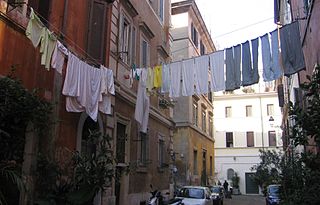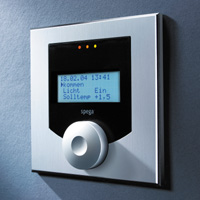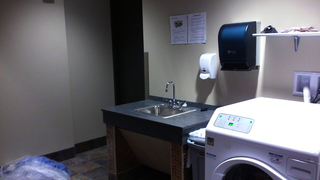
Laundry refers to the washing of clothing and other textiles, and, more broadly, their drying and ironing as well. Laundry has been part of history since humans began to wear clothes, so the methods by which different cultures have dealt with this universal human need are of interest to several branches of scholarship.

A washing machine is a home appliance used to wash laundry. The term is mostly applied to machines that use water as opposed to dry cleaning or ultrasonic cleaners. The user adds laundry detergent, which is sold in liquid, powder, or dehydrated sheet form, to the wash water.

Home automation or domotics is building automation for a home. A home automation system will monitor and/or control home attributes such as lighting, climate, entertainment systems, and appliances. It may also include home security such as access control and alarm systems.

A home appliance, also referred to as a domestic appliance, an electric appliance or a household appliance, is a machine which assists in household functions such as cooking, cleaning and food preservation.

A clothes dryer, also known as tumble dryer or simply dryer, is a powered household appliance that is used to remove moisture from a load of clothing, bedding and other textiles, usually after they are washed in a washing machine.

A laundry room is a room where clothes are washed and dried. In a modern home, a laundry room would be equipped with an automatic washing machine and clothes dryer, and often a large basin, called a laundry tub, for hand-washing delicate articles of clothing such as sweaters, and an ironing board. A typical laundry room is located in the basement of older homes, but in many modern homes, the laundry room might be found on the main floor near the kitchen or upstairs near the bedrooms.

A clothes line, also spelt clothesline and also known as a washing line, is a device for hanging clothes on for the purpose of drying them. It is any type of rope, cord, or twine that has been stretched between two points, outside or indoors, above the level of the ground. Clothing that has recently been washed is hung along the line to dry, using clothes pegs or clothespins. Washing lines are attached either from a post or a wall, and are frequently located in back gardens, or on balconies. Longer washing lines often have props holding up sections in the middle due to the weight of the usually wet clothing.

A car wash, or auto wash, is a facility used to clean the exterior, and in some cases the interior, of cars. Car washes can be self-service, full-service, or fully automated. Car washes may also be events where people pay to have their cars washed by volunteers, often using less specialized equipment, as a fundraiser.
A fabric softener or fabric conditioner is a conditioner that is applied to laundry after it has been washed in a washing machine. A similar, more dilute preparation meant to be applied to dry fabric is known as a wrinkle releaser.

A laundry ball or washing ball is a product made of solid, insoluble material promoted as a substitute for laundry detergent. Producers of laundry balls often make pseudoscientific claims about their mechanisms of action and exaggerate the extent of their benefits.

A combo washer dryer is a combination in a single cabinet of a washing machine and a clothes dryer. It should not be confused with a "stackable" combination of a separate washing machine and a separate clothes dryer.

A self-service laundry, coin laundry, or coin wash, is a facility where clothes are washed and dried without much personalized professional help. They are known in the United Kingdom as launderettes or laundrettes, and in the United States, Canada, Australia and New Zealand as laundromats. In Texas and other parts of the south central United States, the term washateria is still used by some older speakers.
Staber Industries, Inc. is a manufacturer of residential laundry home appliances, with headquarters in Groveport, Ohio. The products they currently manufacture include a washing machine, a clothes dryer, and a clothes drying cabinet.

The Thor washing machine was the first electric clothes washer sold commercially in the United States. Produced by the Chicago-based Hurley Electric Laundry Equipment Company, the 1907 Thor is believed to be the first electrically powered washer ever manufactured, crediting Hurley as the inventor of the first automatic washing machine. Designed by Hurley engineer Alva J. Fisher, a patent for the new electric Thor was issued on August 9, 1910, three years after its initial invention.

A domestic robot is a type of service robot, an autonomous robot that is primarily used for household chores, but may also be used for education, entertainment or therapy. While most domestic robots are simplistic, some are connected to Wi-Fi home networks or smart environments and are autonomous to a high degree. There were an estimated 16.3 million service robots in 2018.
Laundroid was a laundry-folding machine and home robot, used to automatically wash, dry, iron, sort and fold clothes to a dedicated closet. It was dubbed to be the world's first laundry folding robot, and was planned to go on sale in Japan first, and subsequently, in a limited number, in the United States. Release date was set to 2017, with pre-orders starting in March 2017.
FoldiMate was a California-based company developing a robotic laundry-folding machine founded in 2012. Their clothes folding machine was aimed to enter the market by the end of 2019. In 2021, the company folded.

A missing sock, lost sock, or odd sock is a single sock in a pair of socks known or perceived to be permanently or temporarily missing. Socks are usually perceived to be lost immediately before, during, or immediately after doing laundry.
Poplin is an American company which allows people to hire independent contractors to wash, dry, fold, and deliver laundry. SudShare was co-founded in 2018 by Mort and Nachshon Fertel in Baltimore, Maryland, and operates through a mobile app of the same name. The service is available in over 400 American cities.














